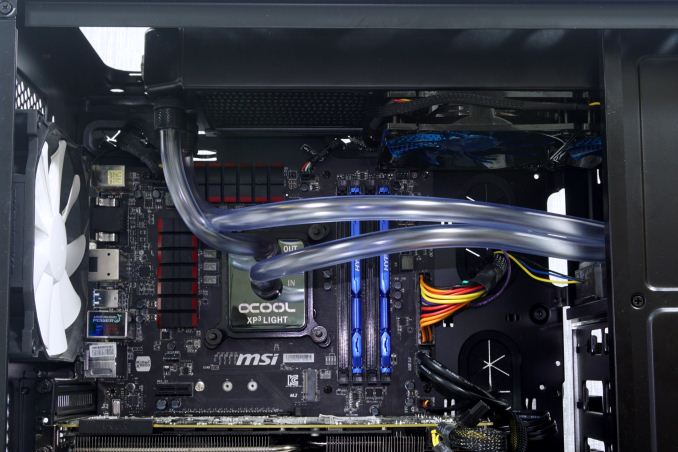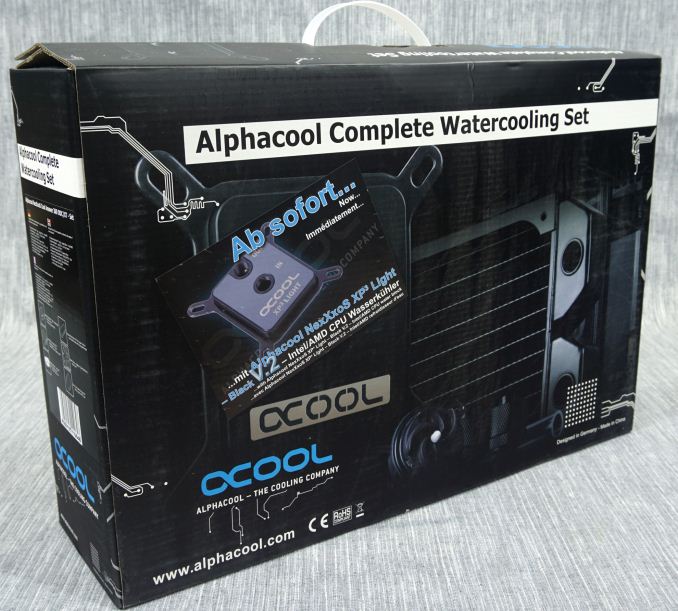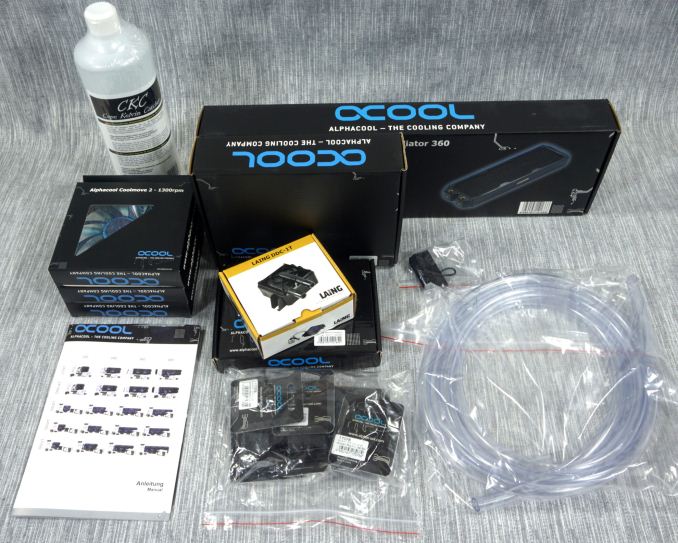The Alphacool NexXxoS Cool Answer 360 DDC/XT Liquid Cooling Kit Review
by E. Fylladitakis on October 24, 2016 9:30 AM EST
Not so long ago, PC liquid cooling was considered to be an extreme approach, one performed by hardcore enthusiasts and overclockers alone. There were no commercial products available and every individual system was designed by the user. Radiators were modified heater cores extracted from cars, CPU blocks were rare and occasionally machined at local workshops using a copper block and a mill, while high-performance tubing came from shops with medical supplies.
As demand grew, aided by the ever-increasing noise of small CPU heatsinks, companies specializing in these "open loop" liquid cooling solutions began turning up -- a little too fast perhaps, as tens of companies were founded within a few months' time and very few of them actually survived for more than a couple of years. Enthusiasts could then buy specialized liquid cooling equipment and even whole kits from just one seller and only had to assemble the setup into their system. That of course is no simple process for an amateur and a nightmare for a system builder, who had to find ways to ship systems pre-filled with coolant or assume that the user has the skills required to fill & maintain such a system. The payoff in terms of cooling was often immense, but the potential market remained limited to advanced users only.
Liquid coolers finally achieved adoption with the wider enthusiast use base at the start of this decade, when the likes of Asetek and CoolIT Systems came up with an inexpensive closed loop solutions, a design was just as simple to install as a common air cooler and required virtually no maintenance at all. However, as convenient as these all-in-one (AIO) solutions may be, hardcore enthusiasts find them lacking and inflexible. Some of the compact AIO designs can hardly compete against air-based solutions in terms of performance. A few companies began making their systems expandable, but the main parts of the system still cannot be upgraded. As such, AIO coolers rarely are acceptable solutions for the most hardcore of enthusiasts and overclockers, who need the best performance and still prefer designing and building their own liquid cooling systems.
Alphacool is a German designer and manufacturer of liquid cooling systems for PCs who has also diversified into producing liquid cooling systems for industrial and medical applications. They are one of the oldest companies in the field and, even though we did have a review of their recent Eisbaer AIO solutions, their specialization lies with the design, manufacturing and supply of high performance liquid cooling parts for advanced PCs.
Except from individual parts, Alphacool also supplies their products as complete pre-tested kits. It is one of these kits that we will be reviewing today, the NexXxoS Cool Answer 360 DDC/XT. The kit includes:
- 1x Alphacool NexXxoS XP3 Light Cooling Block
- 1x Alphacool Repack 5,25 Bay Reservoir
- 1x Laing 12V DDC-1T Pump
- 1x Alphacool NexXxoS XT45 Full Copper Radiator
- 3 meters AlphaTube tubing HF 13/10 (3/8“ID) - clear
- 6x Alphacool HF 13/10 Compression Fittings G1/4
- 3x 120 mm Alphacool Coolmove Fans
- 1x Alphacool CKC Cape Kelvin Catcher Liquid 1000ml
- 1x ATX-bridging plug (24 Pin) - black
Packaging & Bundle
Alphacool supplies the NexXxoS Cool Answer 360 DDC/XT kit in a large, very sturdy cardboard box. The artwork is simple, based on pictures of the included parts and basic information about the kit.
Every included part is packed in its own cardboard box, meaning that the exterior box only provides shipping convenience and protection. The packaging of the individual parts, with the exception of the liquid pump, bears the Alphacool company logo. The clear PVC tubing does not have its own packaging, though that would be redundant as it is nearly impossible to damage such an item during transport. Alphacool also supplies a thorough manual.












40 Comments
View All Comments
saratoga4 - Monday, October 24, 2016 - link
>copper block and a latheCopper block and mill. Lathe is the spinning one that works on pipes, mills are the drill type devices that cut blocks.
And yes, milling my first gpu cooling was pretty annoying. So much nicer these day :)
DanNeely - Monday, October 24, 2016 - link
Having used open loop coolers for the better part of a decade, I'll second that the DDC pump is going to be the loudest part if running at full speed unless you go crazy with fans. (I really wish someone would design a more suitable pump from the ground up instead of just slapping a modified top on the stock model.) However while it's picky about it's operating voltage you can slow and quiet them using PWM control. My current loop has a CPU, Mobo Mosfets, GPU, and a 560 radiator. Using an 4yo Swiftech DDC pump (not sure exact model they've got several of them) I've found that PWMing it to about 70% drops the high pitched pump noise below the noise floor of my low speed fans while only raising core temps by about 1-2C.Oxford Guy - Tuesday, November 8, 2016 - link
The pump in the EK L 2.0 kits is pretty quiet when suspended.Andrew LB - Wednesday, February 8, 2017 - link
I'm surprised they didn't use a pump like the DDC-1T PWM which is a 10w version that does 420l/h and is pretty much silent. I have one in my PC and even with an XSPC Raystorm V3 CPU block, Aquacomputer Krygraphics GTX 780ti full block, XSPC ex360 and ex280 radiators, and quite a few 90' and 45' XSPC rotary fittings, my DDC-1T PWM has a flow rate of 0.91gpm according to my Aquacomputer Aquaero with high-flow meter.Aerodrifting - Monday, October 24, 2016 - link
The part which the pump connects to the reservoir really concerns me. From the looks of it, It's just the barbs that come with DDC stock top (which we usually replace with custom ones to fit standard fittings plus better flow) go straight into the opening of the reservoir without any tightening measures. Are you sure that is not going to leak?BrokenCrayons - Monday, October 24, 2016 - link
The benchmark results are pretty impressive, but hardly worth the risk of mixing liquid with electricity or the added cost over just using the manufactuerer certified heatsink and fan that comes in the box with the CPU. So the processor runs at 40 degrees instead of 70. That's utterly meaningless to me when the max temp for a chip is typically +90 degrees and certainly not worth any additional cost at all much less a cost that includes the problem of pumping fluids around a system that works perfectly well with circulating air.Death666Angel - Monday, October 24, 2016 - link
It's a hobby. It can have some benefits, but it's a hobby first and foremost in my opinion. Yes, I could overclock my CPU and GPU some more while under water, it has a bit less noise and it can be more versatile. But modern aircooling is also pretty good, usually cheaper and not that much louder if you select good components. Though I will always spend a bit more to get a better cooler compared to the boxed offerings (headroom in the summer, dust buildup, better overclocking, quieter operations). But it depends on your setup and taste. :)BrokenCrayons - Monday, October 24, 2016 - link
That I can understand. Everyone has something they waste time and money on just for fun, but I don't think there's a practical reason behind it. I leave my desktop computer with it's 95W 860K CPU sitting in the mud room (no AC...basically my front porch) and run it headlessly to stream games. It spent the summer in ambient temps of around 80-85 degrees streaming games via Steam and the entire time it was and still is on the pre-Wraith HSF that came in the box with the CPU.Sure, I thought about replacing the cooler with something non-OEM or even getting a Wraith second hand from ebay or something, but there's absolutely no reason to do so. I can't rationalize spending even a minimal amount of money on it and then going through the trouble of opening the case up to replace the HSF. I might clean the dust bunnies out next spring, but at this point any additional cooling would serve no practical purpose.
letmepicyou - Monday, October 24, 2016 - link
There is a VERY practical purpose to water cooling which you're missing. If you've ever used a high end air cooler (and I have a cupboard full of them, up to the top shelf Thermalright Silver Arrow) then you know that they're HEAVY. This isn't a problem if your computer sits at your desk until cleaning time or your next upgrade cycle. I can promise you that having a huge cooler on your motherboard can be precarious if you tend to lug your PC around at all. You have to be pretty ginger with your movements.The reason I went to water cooling is now when I lug my PC around, I don't have to worry about component stresses. Given that I have a nice AIO loop on my CPU and run all SSDs, I could boot kick my tower and not worry about data loss or yanking the mounting post for my air cooler through the fiberglass of my motherboard.
BrokenCrayons - Tuesday, October 25, 2016 - link
Actually, my argument is in favor of OEM-boxed coolers that ship in retail packaging with the CPU. Those have never been too heavy for the mounting mechanisms that support them. The situation of an overweight air cooler is a self-inflicted wound that wouldn't have required the proverbial medical attention of liquid cooling had the person in question never picked up the overweight air cooler knife to begin with.